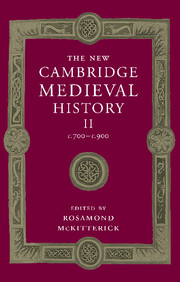Book contents
- Frontmatter
- PART I POLITICAL DEVELOPMENT
- 1 Introduction: sources and interpretation
- 2 The British Isles
- 3 Frankish Gaul to 814
- 4 The Frankish kingdoms, 814–898: the West
- 5 The Frankish Kingdoms, 817–911: the East and Middle Kingdoms
- 6 Fines Imperii: the Marches
- 7 The Vikings in Francia and Anglo-Saxon England to 911
- 8 Scandinavia, c. 700–1066
- 9 Slavs and Bulgars
- 10 The Muslims in Europe
- 11 Spain: the northern kingdoms and the Basques, 711–910
- 12 Lombard and Carolingian Italy
- 13 Byzantine Italy, c. 680–c. 876
- 14 Byzantium and the west, 700–900
- PART II GOVERNMENT AND INSTITUTIONS
- PART III CHURCH AND SOCIETY
- PART IV CULTURE AND INTELLECTUAL DEVELOPMENTS
- Conclusion
- Appendix genealogical tables
- List of primary sources
- Bibliography of secondary works arranged by chapter
- Index of manuscripts
- General index
- Frontispiece">
- Plate section
- Map 4 Charlemagne’s Europe and Byzantium, 814
- Map 19 The ecclesiastical provinces of western Europe 700-900
- Map 20 Carolingian schools, scriptoria and literary centres
- Genealogical table X: Wessex
- References
11 - Spain: the northern kingdoms and the Basques, 711–910
from PART I - POLITICAL DEVELOPMENT
Published online by Cambridge University Press: 28 March 2008
- Frontmatter
- PART I POLITICAL DEVELOPMENT
- 1 Introduction: sources and interpretation
- 2 The British Isles
- 3 Frankish Gaul to 814
- 4 The Frankish kingdoms, 814–898: the West
- 5 The Frankish Kingdoms, 817–911: the East and Middle Kingdoms
- 6 Fines Imperii: the Marches
- 7 The Vikings in Francia and Anglo-Saxon England to 911
- 8 Scandinavia, c. 700–1066
- 9 Slavs and Bulgars
- 10 The Muslims in Europe
- 11 Spain: the northern kingdoms and the Basques, 711–910
- 12 Lombard and Carolingian Italy
- 13 Byzantine Italy, c. 680–c. 876
- 14 Byzantium and the west, 700–900
- PART II GOVERNMENT AND INSTITUTIONS
- PART III CHURCH AND SOCIETY
- PART IV CULTURE AND INTELLECTUAL DEVELOPMENTS
- Conclusion
- Appendix genealogical tables
- List of primary sources
- Bibliography of secondary works arranged by chapter
- Index of manuscripts
- General index
- Frontispiece">
- Plate section
- Map 4 Charlemagne’s Europe and Byzantium, 814
- Map 19 The ecclesiastical provinces of western Europe 700-900
- Map 20 Carolingian schools, scriptoria and literary centres
- Genealogical table X: Wessex
- References
Summary
the kingdom of the asturias, 718–910
the disintegration of the unitary Visigothic kingdom in the Iberian peninsula in the years 710–12, as a consequence of civil war and military defeat at the hands of the invading Arab armies, was both sudden and unforeseen. The actual course of events cannot easily be recovered, owing to the limitations of the extant sources. Arab texts, upon which historians have placed the greatest reliance, are in no case datable to any period earlier than the late tenth century, and even ones that may have originated then are only transmitted in fragmentary form in later works, or show serious indications of interpolation. This and similar evidential problems, together with the inevitable growth of ideologically slanted interpretations of the key episodes, makes it very difficult to assess the immediate consequences of the collapse of the Visigothic kingdom, not least the emergence c. 720 in the north of the peninsula of a minute but independent Christian kingdom in the Asturias (Map 17). That this was the product of the northwards flight of refugees from the other regions of the former Visigothic realm is highly unlikely, as the Arab conquerors made treaties with the regional authorities, the Visigothic counts in most cases, that guaranteed local autonomy in matters of law, administration and religion in return for the payment of fixed capitation and other taxes. For the first half-century or so of Arab domination in Spain local conditions were probably very little affected by changes in central authority.
- Type
- Chapter
- Information
- The New Cambridge Medieval History , pp. 272 - 289Publisher: Cambridge University PressPrint publication year: 1995
References
- 7
- Cited by

